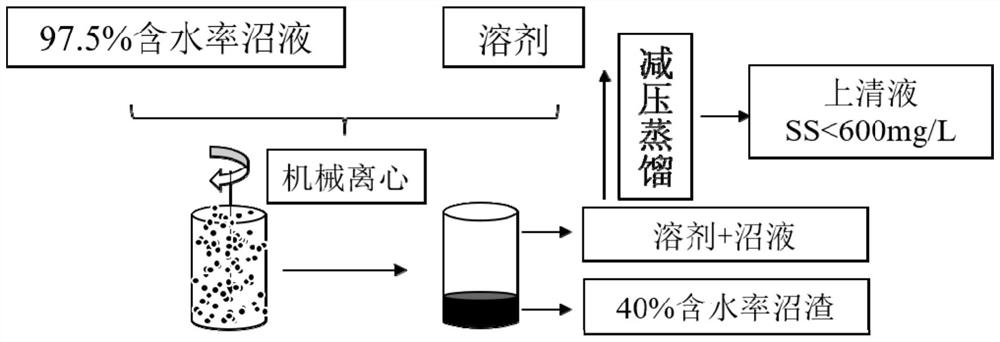Biogas slurry solid-liquid separation treatment method
A technology of solid-liquid separation and treatment method, which is applied in centrifugal separation water/sewage treatment, extraction water/sewage treatment, waste fuel, etc. The corrosion of biogas slurry treatment equipment and other problems can reduce the risk of secondary environmental pollution, reduce the consumption of solid-liquid separation and process operation costs, and reduce the effect of effluent SS.
- Summary
- Abstract
- Description
- Claims
- Application Information
AI Technical Summary
Problems solved by technology
Method used
Image
Examples
Embodiment 1
[0026] Example 1 - Efficient solid-liquid separation treatment of biogas slurry in a kitchen waste treatment plant in Shanghai
[0027] (1) Mix biogas slurry with an initial moisture content of 97.5% and acetonitrile at a mixing mass ratio of 1:1, and extract and stir for 5 minutes;
[0028] (2) The solid-liquid separation is carried out by mechanical centrifugation, the centrifugal speed is 4500rpm, and the centrifugation time is 1min;
[0029] (3) Recover the solvent by distillation under reduced pressure from the supernatant after centrifugation, the operating temperature is 80°C, the vacuum degree is 0.05MPa, and the condensation temperature of the solvent vapor is 8°C; 80°C, vacuum degree 0.05MPa, solvent vapor condensation temperature 8°C.
[0030] (4) The solvent recovery rate in the final biogas residue was 87.5%, and the solvent recovery rate in the supernatant was 92.2%. After recovering the solvent, the final moisture content of the biogas residue was 32%, and the ...
Embodiment 2
[0031] Example 2 - Efficient solid-liquid separation treatment of biogas slurry in a kitchen waste treatment plant in Shanghai
[0032] (1) Mix biogas slurry with an initial moisture content of 97.5% and acetonitrile at a mixing mass ratio of 0.5:1, and extract and stir for 15 minutes;
[0033] (2) The solid-liquid separation is carried out by mechanical centrifugation, the centrifugal speed is 2500rpm, and the centrifugation time is 10min;
[0034] (3) Recover the solvent by distillation under reduced pressure from the supernatant after centrifugation, the operating temperature is 70°C, the vacuum degree is 0.07MPa, and the condensation temperature of the solvent vapor is 14°C; 70°C, vacuum degree 0.07MPa, solvent vapor condensation temperature 14°C.
[0035] (4) The solvent recovery rate in the final biogas residue was 91.3%, and the solvent recovery rate in the supernatant was 97.1%. After recovering the solvent, the final moisture content of the biogas residue was 46%, an...
Embodiment 3
[0036] Example 3 - Efficient solid-liquid separation treatment of biogas slurry in a kitchen waste treatment plant in Shanghai
[0037] (1) Mix biogas slurry with an initial moisture content of 95% and acetonitrile at a mixing mass ratio of 0.1:1, and extract and stir for 30 minutes;
[0038] (2) The solid-liquid separation is carried out by mechanical centrifugation, the centrifugal speed is 1500rpm, and the centrifugation time is 15min;
[0039] (3) Recover the solvent by distillation under reduced pressure from the supernatant after centrifugation, the operating temperature is 80°C, the vacuum degree is 0.08MPa, and the condensation temperature of the solvent vapor is 18°C; 80°C, vacuum degree 0.08MPa, solvent vapor condensation temperature 18°C.
[0040] (4) The solvent recovery rate in the final biogas residue is 89.2%, and the solvent recovery rate in the supernatant is 101.1% (this is because the evaporation of water is also arranged in the recovery process, causing th...
PUM
 Login to View More
Login to View More Abstract
Description
Claims
Application Information
 Login to View More
Login to View More - R&D
- Intellectual Property
- Life Sciences
- Materials
- Tech Scout
- Unparalleled Data Quality
- Higher Quality Content
- 60% Fewer Hallucinations
Browse by: Latest US Patents, China's latest patents, Technical Efficacy Thesaurus, Application Domain, Technology Topic, Popular Technical Reports.
© 2025 PatSnap. All rights reserved.Legal|Privacy policy|Modern Slavery Act Transparency Statement|Sitemap|About US| Contact US: help@patsnap.com

